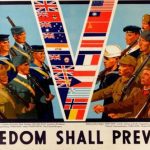 History
History  History
History  Pop Culture
Pop Culture 10 Cases of Grabbing Defeat from the Jaws of Victory
 History
History 10 Common Misconceptions About the Renaissance
 Weird Stuff
Weird Stuff 10 Crazy Things Resulting from Hidden Contract Provisions
 Facts
Facts 10 Unusual Facts About Calories
 Weird Stuff
Weird Stuff 10 Days of Humiliation When the Person Should Have Stayed in Bed
 Humans
Humans 10 Surprising Ways Game Theory Rules Your Daily Life
 Food
Food 10 Popular (and Weird) Ancient Foods
 Animals
Animals Ten Bizarre Creatures from Beneath the Waves
 Technology
Technology 10 Unexpected Things Scientists Made Using DNA
 History
History 10 Events That Unexpectedly Changed American Life
 Pop Culture
Pop Culture 10 Cases of Grabbing Defeat from the Jaws of Victory
 History
History 10 Common Misconceptions About the Renaissance
Who's Behind Listverse?

Jamie Frater
Head Editor
Jamie founded Listverse due to an insatiable desire to share fascinating, obscure, and bizarre facts. He has been a guest speaker on numerous national radio and television stations and is a five time published author.
More About Us Weird Stuff
Weird Stuff 10 Crazy Things Resulting from Hidden Contract Provisions
 Facts
Facts 10 Unusual Facts About Calories
 Weird Stuff
Weird Stuff 10 Days of Humiliation When the Person Should Have Stayed in Bed
 Humans
Humans 10 Surprising Ways Game Theory Rules Your Daily Life
 Food
Food 10 Popular (and Weird) Ancient Foods
 Animals
Animals Ten Bizarre Creatures from Beneath the Waves
 Technology
Technology 10 Unexpected Things Scientists Made Using DNA
10 Typos That Accidentally Changed History
Typos might seem harmless, but history shows otherwise. From missing hyphens that crashed spacecraft to punctuation marks that cost corporations millions, tiny textual errors have triggered outsized consequences. Whether printed in sacred texts, etched into treaties, or typed into trading software, these slip-ups reshaped politics, technology, and entire nations.
Here are 10 real-life typos that didn’t just embarrass—they changed history.
Related: 10 Times That an Innocent Mistake Led to a Tragic Outcome
10 The “Wicked Bible” That Omitted “Not”
In 1631, printers Robert Barker and Martin Lucas released a new edition of the King James Bible that would soon become infamous. Known as the “Wicked Bible,” this version contained a fatal error in Exodus 20:14: instead of the commandment reading, “Thou shalt not commit adultery,” it was misprinted as “Thou shalt commit adultery.” The single missing “not” completely reversed the meaning of one of the Ten Commandments, turning a moral prohibition into an endorsement of sin.
King Charles I and the Archbishop of Canterbury were furious. The mistake was considered not only a theological offense but a national embarrassment, as England’s prestige was closely tied to the printed Bible’s clarity and authority. The two printers were summoned to the Star Chamber, fined £300 (a huge sum at the time), and stripped of their printing license. Most copies of the Wicked Bible were destroyed by royal decree. However, around a dozen still exist today in rare book collections, fetching enormous value as collector’s items.
While some scholars have speculated whether the omission was deliberate—a prank or act of sabotage—there’s no clear evidence to support that. It’s more likely a simple, devastating proofreading error, possibly from setting type too hastily. Regardless, it’s a potent example of how even a single missing word can shake religious institutions, ruin careers, and turn sacred scripture into scandalous copy. The “Wicked Bible” remains one of the most notorious typos in publishing history.[1]
9 A Peace Treaty Typo That Extended the War of 1812
The Treaty of Ghent, signed on December 24, 1814, was meant to formally end the War of 1812 between the United States and Great Britain. Yet major hostilities continued due to the slow pace of transatlantic communication and clerical inconsistencies in versions of the treaty. The most famous example is the Battle of New Orleans, fought on January 8, 1815—two weeks after the treaty was signed. Over 2,000 men were killed or wounded in a conflict that, on paper, should never have happened.
Compounding the problem were drafting irregularities and conflicting instructions sent to negotiators. British and American diplomats had exchanged several versions of the treaty, and small textual differences in language regarding maritime rights and territorial boundaries led to hesitations and misinterpretations. One version even referred to American Native tribes using outdated terminology that was corrected in the final text, but confusion over which version was “official” delayed final ratification in some U.S. quarters.
Though this wasn’t a “typo” in the strictest sense (like a misspelled word), the historical consequences stemmed from the same source: sloppy or inconsistent text. The delayed communication of the treaty and ambiguity in the documents allowed one of the war’s bloodiest battles to unfold after peace had already been negotiated.[2]
8 The $10 Million Comma in a Canadian Contract
In 2006, a tiny punctuation mark caused a multimillion-dollar legal dispute in Canada. Rogers Communications had signed a contract with Aliant Telecom to use utility poles. The key clause stated the agreement would last for “five (5) years and thereafter shall continue for successive five (5) year terms, unless and until terminated by either party upon one (1) year’s written notice.” A single comma after the word “terms” became the crux of a legal debate that ultimately cost Rogers nearly $10 million.
The problem was interpretive: Rogers thought the one-year termination notice could only be invoked after the initial five-year term. However, Aliant argued that the comma allowed termination at any time, even during the first five years. The Canadian Radio-television and Telecommunications Commission (CRTC) sided with Aliant, saying the placement of the comma meant the contract could be ended at any point with one year’s notice. Rogers had banked on five years of guaranteed use and now faced sudden contract termination and the need to renegotiate at higher prices.
The case sparked national conversation about the role of grammar in legal contracts. It led to increased scrutiny in Canadian contract law and even updates to corporate legal writing practices. This incident proved that a single stray mark could shift the balance of power—and cost a corporation millions.[3]
7 The Typo That Made “Dewey Defeats Truman” a Headline
On November 3, 1948, Americans woke up to see a bold, black headline across the front page of the Chicago Daily Tribune: “Dewey Defeats Truman.” The only problem? Thomas Dewey had not defeated Harry S. Truman. In fact, Truman had pulled off a stunning comeback victory. The newspaper had printed the headline early due to tight publication deadlines, a union labor strike that forced the paper to go to press earlier than usual, and overconfidence in flawed polling data that projected Dewey as the winner.
Editors at the Tribune had trusted early reports and assumed their headline would be safe. After all, nearly every major political analyst expected Dewey to win. However, as the real results trickled in, it became clear Truman had carried crucial swing states. The paper had to scramble to correct its next editions, but by then, thousands of misprinted copies had already been distributed. Truman himself was famously photographed holding up the incorrect newspaper with a broad, ironic smile.
The phrase “Dewey Defeats Truman” has since entered the cultural lexicon as shorthand for any prediction that blows up in spectacular fashion.[4]
6 The NASA Hyphen That Crashed a Rocket
In 1962, NASA launched the Mariner 1 spacecraft, intended to be the first American probe to fly by Venus. But just 293 seconds after liftoff, the rocket was destroyed by mission control. The reason? A tiny error in the guidance system’s code, specifically, a missing hyphen. The absence of this single character caused the onboard computer to misread velocity data, leading the rocket wildly off course. Fearing a catastrophic crash, NASA had no choice but to trigger the self-destruct mechanism.
The faulty code was meant to instruct the rocket’s systems to correct only for minor variations in trajectory. But without the hyphen, it interpreted normal guidance data as an error, triggering unnecessary course corrections. This caused the rocket to behave erratically. NASA engineers later confirmed that a hyphen meant to indicate a smoothing function had been omitted during transcription from a handwritten formula.
Dubbed by Arthur C. Clarke as “the most expensive hyphen in history,” the Mariner 1 incident cost NASA around $18.5 million—equivalent to over $170 million today.[5]
5 The Fat-Finger Trade That Cost a Japanese Bank $225 Million
In 2005, a catastrophic typo in Japan’s stock market led to one of the most expensive “fat-finger” errors in financial history. A trader at Mizuho Securities intended to sell 1 share of a newly listed recruitment firm, J-Com, for ¥610,000 (about $5,000 at the time). Instead, the order was mistakenly entered as 610,000 shares for ¥1 each. That order was not only undervalued — it was impossible, as J-Com had only issued about 14,000 shares.
The error slipped past safeguards and was executed immediately. Mizuho tried to cancel the trade but was blocked by technical limitations on the Tokyo Stock Exchange’s system. Buyers took advantage of the offer within minutes, and Mizuho reportedly lost over $225 million.
The glitch forced the Tokyo Stock Exchange’s president to resign and prompted major changes in Japan’s trading infrastructure. Today, the event remains a classic example of how a single misplaced digit can cause international financial chaos.[6]
4 The Treaty of Waitangi Translation Error That Still Affects New Zealand
In 1840, the Treaty of Waitangi was signed between representatives of the British Crown and more than 500 Māori chiefs, establishing British governance in New Zealand. But the treaty was written in two languages — English and Māori — and the translations were far from equivalent. The English version stated that Māori chiefs ceded “sovereignty” to the British Crown. However, the Māori version used the word kawanatanga, better translated as “governance,” a much softer term.
Many Māori leaders believed they were agreeing to British protection and law enforcement, not full colonization or land forfeiture. Meanwhile, the British took the agreement as a total transfer of sovereignty. This discrepancy laid the groundwork for decades of land disputes, legal battles, and social inequality.
To this day, the Treaty of Waitangi remains at the heart of New Zealand’s constitutional and legal framework. The country has established a Waitangi Tribunal to investigate historical grievances, but the translation issue continues to influence national dialogue.[7]
3 The 1872 Ballot Typo That Disqualified Thousands of Votes
In the 1872 U.S. presidential election, a simple typographical error may have affected the vote count in a pivotal state. While President Ulysses S. Grant ultimately won reelection comfortably, a critical mistake occurred on ballots in Indiana. On the official ballot for one county, Horace Greeley’s name was misspelled as “Horace Greely”—missing the second “e” in his surname.
Election officials determined that ballots bearing the misspelling were technically invalid, disqualifying over 3,000 votes for Greeley. While this didn’t swing the overall election, it highlighted how minor typographic differences could be challenged under strict election law.
The episode remains a footnote in election history. Still, it offers a clear example of how a single letter can disenfranchise voters — and how even a presidential campaign can hinge on spelling.[8]
2 The “Repeal” That Wasn’t: A Clerical Mistake in Prohibition Law
When the 21st Amendment repealed Prohibition in 1933, many Americans rejoiced—legally purchasing alcohol was once again permitted. But in Kansas, things didn’t go as smoothly. A clerical oversight in a related state bill left outdated, restrictive language on the books. While federal law now allowed alcohol, Kansas maintained restrictions due to the failure to repeal old statutes.
Some counties interpreted the old language as invalid, while others continued to treat Prohibition as in force. This led to patchwork enforcement and ongoing bootlegging. It wasn’t until years later that Kansas fully updated its laws. The state technically remained “dry” until 1948—and to this day, dozens of Kansas counties still have alcohol restrictions.
What was meant to be a straightforward repeal turned into a decades-long legal tangle—all thanks to bureaucratic oversight.[9]
1 The Mars Climate Orbiter That Crashed Over a Unit Conversion Typo
In 1999, NASA launched the Mars Climate Orbiter to study the Red Planet’s atmosphere. However, the $125 million mission ended in disaster due to a critical error: one engineering team used imperial units, while the other used metric. Lockheed Martin provided thrust data in pound-seconds, while NASA’s navigation team expected newton-seconds. The mismatch caused the probe to fly too close to Mars, where it likely disintegrated in the atmosphere.
Because both systems were correct within their own unit conventions, the mistake wasn’t caught until it was too late. The crash became a textbook example of poor cross-team integration—and the dire consequences of failing to standardize measurements.
NASA implemented major reforms, including rigorous cross-verification protocols. The Mars Climate Orbiter remains one of the most expensive and preventable typos in space history.[10]








